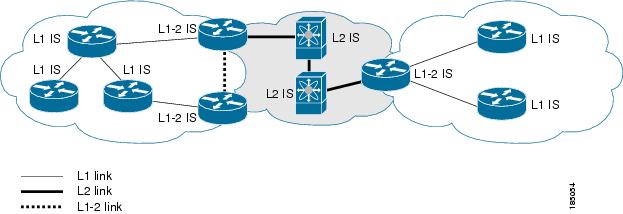IS-IS
Intermediate System to Intermediate System (IS-IS) is an Interior Gateway Protocol (IGP) based on Standardization (ISO)/International Engineering Consortium (IEC) 10589 that
-
supports Internet Protocol version 4 (IPv4) and IPv6
-
is a dynamic link-state routing protocol, and
-
can detect changes in the network topology and calculate loop-free routes to other nodes in the network.
Each router running IS-IS maintains a link-state database that describes the state of the network and sends packets on every configured link to discover neighbors. IS-IS floods the link-state information across the network to each neighbor. The router also sends advertisements and updates on the link-state database through all the existing neighbors.
IS-IS hello packets and adjacency formation
Intermediate System to Intermediate System (IS-IS) sends a hello packet out every configured interface to discover IS-IS neighbor routers. The hello packet contains information such as:
-
authentication details
-
are information
-
supported protocols
The receiving interface uses these information to determine compatibility with the originating interface. Additionally, hello packets are padded to ensure that IS-IS only forms adjacencies with interfaces that have matching maximum transmission unit (MTU) settings.
Compatible interfaces form adjacencies, which update routing information in the link-state database through link-state update messages (LSPs). By default, the router sends a periodic LSP refresh every 10 minutes and the LSPs remain in the link-state database for 20 minutes (the LSP lifetime). If the router does not receive an LSP refresh before the end of the LSP lifetime, the router deletes the LSP from the database.
The LSP interval must be less than the LSP lifetime or the LSPs time out before they are refreshed.
IS-IS sends periodic hello packets to adjacent routers. If you configure transient mode for hello packets, these hello packets do not include the excess padding used before IS-IS establishes adjacencies. If the MTU value on adjacent routers changes, IS-IS can detect this change and send padded hello packets for a period of time. IS-IS uses this feature to detect mismatched MTU values on adjacent routers. For more information, see Configuring the Transient Mode for Hello Padding.
IS-IS areas
An IS-IS area is a network segment within an IS-IS routing domain that organizes routers for efficient routing. IS-IS areas can be designed as a single area encompassing all routers or as multiple areas connected through a backbone, known as the Level 2 area.
-
Level 1 areas: consist of routers called Level 1 routers. These routers establish adjacencies and perform routing only within their local area, known as intra-area routing.
-
Level 2 areas: consist of Level 2 routers that establish adjacencies with other Level Level 2 routers and handle routing between Level 1 areas, known as inter-area routing.
-
A router can be configured as both Level 1 and Level 2, called a Level 1/Level 2 router. These routers act as area border routers, routing traffic between the local Level 1 area and the Level 2 backbone area. See figure IS-IS Network Divided into Areas.
Within a Level 1 area, routers know how to reach all other routers in that area. The Level 2 routers know how to reach other area border routers and other Level 2 routers. Level 1/Level 2 routers straddle the boundary between two areas, routing traffic to and from the Level 2 backbone area. Level1/Level2 routers use the attached (ATT) bit signal Level 1 routers to set a default route to this Level1/Level2 router to connect to the Level 2 area.
In some instances, such as when you have two or more Level1/Level 2 routers in an area, you may want to control which Level1/Level2 router that the Level 1 routers use as the default route to the Level 2 area. You can configure which Level1/Level2 router sets the attached bit. For more information, see the Verifying the IS-IS Configuration section.
Each IS-IS instance in Cisco NX-OS supports either a single Level 1 or Level 2 area, or one of each. By default, all IS-IS instances automatically support Level 1 and Level 2 routing.

An autonomous system boundary router (ASBR) advertises external destinations throughout the IS-IS autonomous system. External routes are the routes redistributed into IS-IS from any other protocol.
NET and system ID
A Network Entity Title (NET) is a unique identifier associated with each IS-IS (Intermediate System to Intermediate System) instance. It serves to identify the IS-IS instance within an area and consists of two key components:
-
System ID: A unique identifier that distinguishes the IS-IS instance within the area.
-
Area ID: Identifies the IS-IS area to which the instance belongs.
For example, if the NET is 47.0004.004d.0001.0001.0c11.1111.00, the system ID is 0000.0c11.1111.00 and the area is ID 47.0004.004d.0001.
Designated intermediate systems
IS-IS uses a designated intermediate system (DIS) in broadcast networks to prevent each router from forming unnecessary links with every other router on the broadcast network. IS-IS routers send LSPs to the DIS, which manages all the link-state information for the broadcast network. You can configure the IS-IS priority that IS-IS uses to select the DIS in an area.
 Note |
No DIS is required on a point-to-point network. |
 Feedback
Feedback